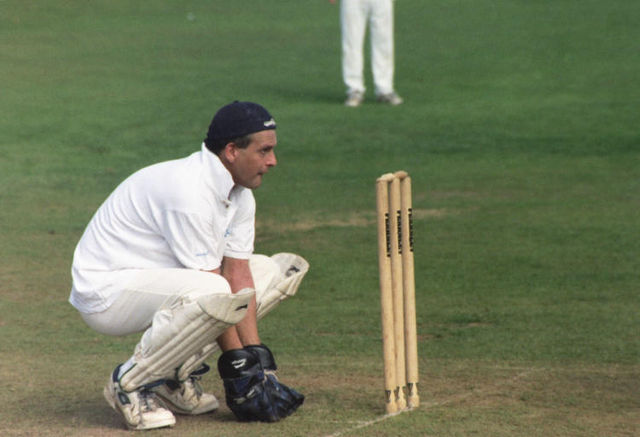The wicket-keeper in the sport of cricket is the player on the fielding side who stands behind the wicket or stumps being watchful of the batsman and ready to take a catch, stump the batsman out and run out a batsman when occasion arises. The wicket-keeper is the only member of the fielding side permitted to wear gloves and external leg guards. The role of the keeper is governed by Law 27 and of the Laws of Cricket.
Wicket-keeper in characteristic full squatting position, facing a delivery from a slow pace or spin bowler
Wicket-keeper in characteristic partial squatting position (together with slip fielders), facing a delivery from a fast bowler.
Adam Gilchrist of Australia standing up to the stumps against England during the fourth test of the 2005 Ashes series in England.
Wicket keeping gloves along with the inner gloves
Cricket is a bat-and-ball game that is played between two teams of eleven players on a field at the centre of which is a 22-yard (20-metre) pitch with a wicket at each end, each comprising two bails balanced on three stumps. Two players from the batting team stand in front of either wicket, with one player from the fielding team bowling the ball towards the striker's wicket from the opposite end of the pitch. The striker's goal is to hit the bowled ball and then switch places with the nonstriker, with the batting team scoring one run for each exchange. Runs are also scored when the ball reaches or crosses the boundary of the field or when the ball is bowled illegally.
Shaun Pollock of South Africa bowls to Michael Hussey of Australia during the 2005 Boxing Day Test match at the Melbourne Cricket Ground
A medieval "club ball" game involving an underarm bowl towards a batter. Ball catchers are shown positioning themselves to catch a ball. Detail from the Canticles of Holy Mary, 13th century.
Evolution of the cricket bat. The original "hockey stick" (left) evolved into the straight bat from c. 1760 when pitched delivery bowling began.
Francis Cotes, The Young Cricketer, 1768








